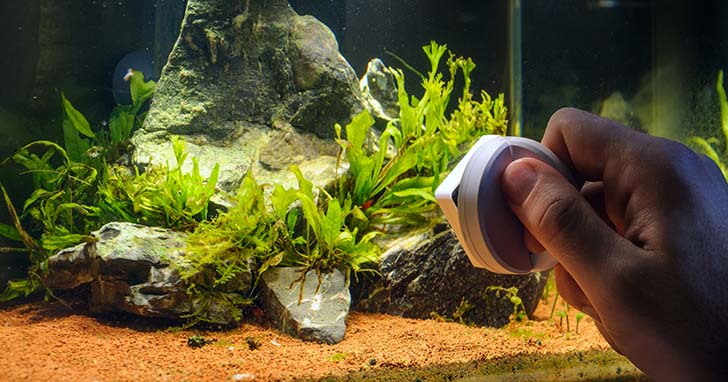Easy Ways to Control Algae Growth in Aquariums

Should I let algae grow in aquariums?
The appearance and growth of algae in an aquarium is not necessarily bad. In fact, it is the natural order of things. It shows that your aquarium is well balanced and healthy. However, this starts to become a problem when it starts growing out of control. Left unchecked, it can cover the glass - in colors ranging from black to bright green in freshwater, or even pink, purple, or burgundy in saltwater, eventually obstructing your view of the inhabitants of the tank, as well as causing problems for them in terms of lack of light. Algae keeps things looking natural and provides a food source for fish and microorganisms. Thus, your goal should not be to eliminate all algae. Instead, it should be to manage its growth to keep the population at a desirable level. Aquarists with less experience tend to make the mistakes of treating the symptoms, as opposed to treating the problem at the core. An unfocused, general treatment of the tank to get rid of algae have detrimental effects on the aquarium as a whole, but more importantly, for the aquatic life in the tank. Knowing what factors contribute to algae growth, and your management options, will help you keep a healthy, well-balanced aquarium. How do you control algae growth in aquariums?
Test your waterTo avoid algae problems, it is good practice to test your aquarium water regularly, and your tap water before water changes. If you already have an algae problem, your first step should be to test your tap water. If the test results show significant levels of phosphate, nitrate, or iron, your battle against algae will be futile until levels are reduced. Identify problems caused by phosphateCommon phosphate sources include tap water and fish food. To avoid unwanted phosphate levels, make sure no uneaten food is allowed to remain in the aquarium. The most effective means to reduce or eliminate phosphate already present are a reverse osmosis (RO) unit or a tap water filter. Commercial phosphate removers or a combination Carbon-Phosphate Remover can also be effective. Employ high-grade filters and mediaAlgae thrives on excess nutrients, nitrate, and iron which result from a number of factors, including overstocking, overfeeding, contaminated tap water, and failure to do timely water changes. To help lower nutrients, use of a premium grade carbon will help reduce dissolved organics and metals and slow the return of algae. However, if certain types of hair algae appear in your aquarium you may have a persistent problem that requires tougher measures. The right choice of filter media can also make a big difference in phosphate levels: Poly Filters, which can be used to filter your aquarium and pre-filter tap water, will remove phosphate, iron, and heavy metals. These filters change color to indicate what they are removing. How to maintain water quality in aquariums
Routine partial water changes of about one-fourth, every three to four weeks minimum, helps remove excess organics. Ideally, for saltwater, use water purified through reverse osmosis (RO). If you are using tap water which contains chlorine, be sure to add a dechlorinator, and, if algae nutrients are present, run it through a prefilter. To minimize the amount of organic matter in the water, do not add any new fish while it has excess algae, and feed your fish only what they can consume in a couple of minutes. Liquid algae controls such as AlgaeFix are safe and effective in freshwater aquariums. Once you have taken care of the root problem, you can use them to help clean up your aquarium and prevent new growth. Can you control algae through fish?
In aquariums, the addition of certain types of fish are a win-win strategy. You get to enjoy the fish and they get to enjoy the algae. Many varieties of freshwater fish, such as Plecos, include algae in their diet, as do saltwater fish, including Tangs and most Angelfish. Also, in saltwater, macroalgae species can be cultivated in the aquarium to control unwanted pests types like slime, hair, fungus and bacteria forms. How does lighting control algae growth?
If algae growth is fast, your aquarium may be getting too much light, even if carefully positioned out of the sun's direct rays. You might need to block reflected light or decrease the amount of time you illuminate your aquarium. Since algae requires light and nutrients to grow, you may consider running your lights for shorter periods of time. It has also been shown that some algae appear to grow better as light intensity decreases. Consider changing bulbs as the intensity diminishes on aquarium bulbs over time. Can you manually remove algae?
The simplest control method is also the most economical. You can reach into the aquarium and scrub it away with Marine Economy Algae Scrubb. You can also remove excess amounts by siphoning or filtration. Manual cleaning won't prevent the return of algae, but it helps make other management methods more effective. Whatever manual cleaning method you use, do not leave loose algae floating about in your aquarium where it will decay, increasing the amount of dissolved organic material and lowering the oxygen level. Most algae problems can be managed, especially if diagnosed early. Using a combination of the techniques above, you can keep your aquarium clean and colorful. |
|
|


